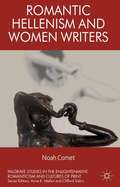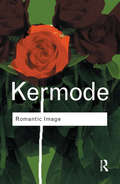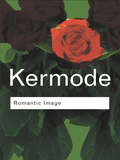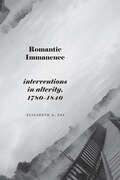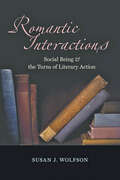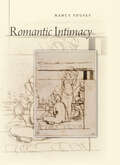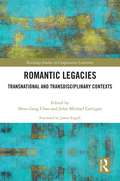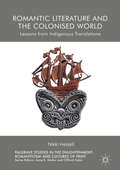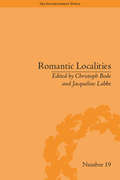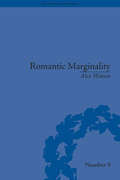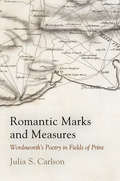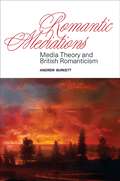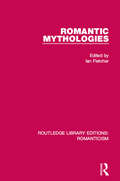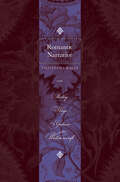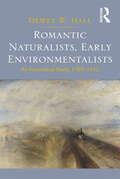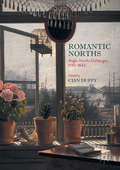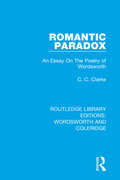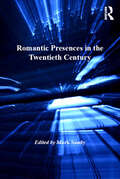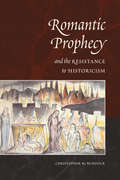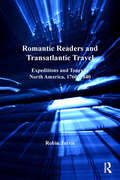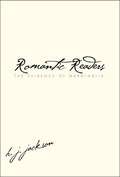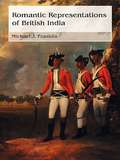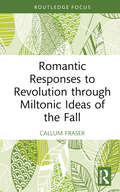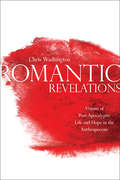- Table View
- List View
Romantic Hellenism and Women Writers
by Noah CometExamining popular contexts of Greek revivalism associated with women, Comet challenges the masculine narrative of English Classicism by demonstrating that it thrived in non-male spaces, as an ephemeral ideal that betrayed a distrust of democratic rhetoric that ignored the social inequities of the classical world.
Romantic Image (Routledge Classics)
by Frank KermodeFor the past four decades Frank Kermode, critic and writer, has steadily established himself as one of the most brilliant minds of his generation. Questioning the public's harsh perception of 'the artist', Kermode at the same time gently pokes fun at artists' own, often inflated, self-image. He identifies what has become one of the defining characteristics of the Romantic tradition - the artist in isolation and the emerging power of the imagination. Back in print after an absence of over a decade, The Romantic Image is quintessential Kermode. Enlightenment has seldom been so enjoyable!
Romantic Image (Routledge Classics)
by Frank KermodeFor the past four decades Frank Kermode, critic and writer, has steadily established himself as one of the most brilliant minds of his generation. Author and editor of over forty books, his prodigious output includes some of the best literary criticism to be published. Questioning the public's harsh perception of 'the artist', Kermode at the same time gently pokes fun at artists' own, often inflated, self-image. He identifies what has become one of the defining characteristics of the Romantic tradition - the artist in isolation and the emerging power of the imagination. The ingeniousness of Kermode's argument and the polish and wit of the writing all serve to identify the book as one of his finest offerings. Back in print after an absence of over a decade, The Romantic Image is quintessential Kermode. Small wonder then that this, one of his earliest works, is such a classic. Enlightenment has seldom been so enjoyable!
Romantic Immanence: Interventions in Alterity, 1780–1840 (SUNY series, Studies in the Long Nineteenth Century)
by Elizabeth A. FayRomantic Immanence examines literary examples of an alternative experience of otherness—an experience of alterity the Romantics understood as an embodied, immanent encounter with raw reality. The Romantics' enthusiasm for encounters in nature and the imagination that exceeded the limits of rational thought is well known. Yet these encounters have largely been interpreted in terms of the sublime or the Gothic. Drawing attention to the influence of Spinozist and Stoic philosophy on Romantic thought and aesthetics, Elizabeth A. Fay argues that immanence was another, perhaps even more important, form of alterity, particularly during this era of social and political upheaval. Investigating works such as Coleridge's Rime of the Ancient Mariner, Dorothy Wordsworth's Grasmere Journals, and Percy Shelley's Triumph of Life alongside Schelling's unfinished Ages of the World and Schlegel's Athenaeum Fragments, Fay demonstrates how Romantic immanence, despite going largely unrecognized with the loss of its initial context, remains vividly present in these works.
Romantic Interactions: Social Being and the Turns of Literary Action
by Susan J. WolfsonIn Romantic Interactions, Susan J. Wolfson examines how interaction with other authors—whether on the bookshelf, in the embodied company of someone else writing, or in relation to literary celebrity—shaped the work of some of the best-known (and less well-known) writers in the English language. Working across the arc of Long Romanticism, from the 1780s to the 1840s, this lively study involves writing by women and men, in poetry and prose. Combining careful readings with sophisticated literary, historical, and cultural criticism, Wolfson reveals how various writers came to define themselves as "author." The story unfolds not only in deft textual analyses but also by provocatively placing writers in dialogue with what they were reading, with one another, and with the community of readers (and writers) their writings helped bring into being: Mary Wollstonecraft and Charlotte Smith in the Revolution-roiled 1790s; William Wordsworth and Dorothy Wordsworth in the society of the Lake District; Lord Byron, a magnet for writers everywhere, inspired, troubled, but always arrested by what he (and his scandal-ridden celebrity) represented. This fresh, informative account of key writers, important texts, and complex cultural currents promises keen interest for students and scholars, literary critics, and cultural historians.
Romantic Intimacy
by Nancy YousefHow much can we know about what other people are feeling and how much can we sympathize or empathize with them? The term "intimacy"¿which has always referred both to the inmost and personal, and to relationships of exceptional closeness¿captures a tension between a confidence in the possibility of shared experience and a competing belief that thoughts and feelings are irreducibly private. This book is an interdisciplinary study of shared feeling as imagined in eighteenth-century ethics, romantic literature, and twentieth-century psychoanalysis. Original interpretations of Hume, Rousseau, Kant, Wordsworth, Coleridge, and Austen show how aspirations toward mutual recognition give way to appreciation of varied, nonreciprocal forms of intimacy. The book concludes with accounts of empathy and unconscious communication in the psychoanalytic setting, revealing the persistence of romantic preoccupations in modernity. Yousef offers a compelling account of how philosophical confidence in fellow-feeling and sympathy is transformed by literary attention to uneven forms of emotional response, including gratitude, disappointment, distraction, and absorption. In its wide-ranging and eclectic engagement with current debates on the relationship between ethics, affect, and aesthetics, the book will be crucial reading for students of eighteenth- and nineteenth-century culture, as well as for literary theorists.
Romantic Legacies: Transnational and Transdisciplinary Contexts (Routledge Studies in Comparative Literature)
by John Michael Corrigan Shun-Liang ChaoRomantic Legacies: Transnational and Transdisciplinary Contexts presents the most wide-ranging treatment of Romantic regenerations, covering the cross-pollination between the arts or between art and thought in Germany, Britain, France, the US, Russia, India, China, and Japan. Each chapter in the volume examines a legacy or afterlife in a comparative context to demonstrate ongoing Romantic legacies as fully as possible in their complexity and richness. The volume provides readers a lens through which to understand Romanticism not merely as an artistic heritage but as a dynamic site of intellectual engagement that crosses nations and time periods and entails no less than the shaping of our global cultural currents.
Romantic Literature and the Colonised World: Lessons from Indigenous Translations (Palgrave Studies in the Enlightenment, Romanticism and Cultures of Print)
by Nikki HessellThis book considers indigenous-language translations of Romantic texts in the British colonies. It argues that these translations uncover a latent discourse around colonisation in the original English texts. Focusing on poems by William Wordsworth, John Keats, Felicia Hemans, and Robert Burns, and on Walter Scott’s Ivanhoe, it provides the first scholarly insight into the reception of major Romantic authors in indigenous languages, and makes a major contribution to the study of global Romanticism and its colonial heritage. The book demonstrates the ways in which colonial controversies around prayer, song, hospitality, naming, mapping, architecture, and medicine are drawn out by translators to make connections between Romantic literature, its preoccupations, and debates in the nineteenth- and early twentieth-century colonial worlds.
Romantic Localities: Europe Writes Place (The Enlightenment World #19)
by Christoph Bode Jacqueline LabbeRomantic Localities explores the ways in which Romantic-period writers of varying nationalities responded to languages, landscapes – both geographical and metaphorical – and literatures.
Romantic Marginality: Nation and Empire on the Borders of the Page (The History of the Book #9)
by Alex WatsonThis is the first critical study of Romantic-era annotation or marginalia – footnotes, endnotes, glossaries – which formed a vital site of literary interaction.
Romantic Marks and Measures: Wordsworth's Poetry in Fields of Print (Material Texts)
by Julia S. CarlsonIn the late eighteenth century, British print culture took a diagrammatic and accentual turn. In graphs of emphasis and tonal inflection, in signs for indicating poetic stress, and in tabulations of punctuation, elocutionists, grammarians, and prosodists deployed new typographic marks and measures to represent English speech on the page. At the same time, cartographers and travel writers published reconfigurations of landscape on large-scale topographical maps, in geometric surveys, and in guidebooks that increasingly featured charts and diagrams. Within these diverse fields of print, blank verse was employed as illustration and index, directing attention to newly discovered features of British speech and space and helping to materialize the vocal and visual contours of the nation.In Romantic Marks and Measures, Julia S. Carlson examines Wordsworth's poetry of "speech" and "nature" as a poetry of print, written and read in the midst of topographic and typographic experimentation and change. Investigating the notebook drafts of "The Discharged Soldier," the printer's copy of Lyrical Ballads, Lake District guidebooks, John Thelwall's scansion of The Excursion, and revisions and editions of The Prelude, she explores Wordsworth's major blank verse poems as sites of intervention—visual and graphic as well as formal and thematic—in cultural contests to represent Britain, on the page, as a shared landscape and language community.
Romantic Mediations: Media Theory and British Romanticism (SUNY series, Studies in the Long Nineteenth Century)
by Andrew BurkettFinalist in the 2016 Foreword INDIES Book of the Year Award in the Social Sciences categoryRomantic Mediations investigates the connections among British Romantic writers, their texts, and the history of major forms of technical media from the turn of the nineteenth century to the present. Opening up the vital new subfield of Romantic media studies through interventions in both media archaeology and contemporary media theory, Andrew Burkett addresses the ways that unconventional techniques and theories of storage and processing media engage with classic texts by William Blake, Lord Byron, John Keats, Mary Wollstonecraft Shelley, and others. Ordered chronologically and structured by four crucial though often overlooked case studies that delve into Romanticism's role in the histories of incipient technical media systems, the book focuses on different examples of the ways that imaginative literature and art of the period become taken up and transformed by—while simultaneously shaping considerably—new media environments and platforms of photography, phonography, moving images, and digital media.
Romantic Mythologies (Routledge Library Editions: Romanticism #9)
by Ian FletcherFirst published in 1967. These essays illustrate the movement of ideas in the literary and artistic history of the later part of the nineteenth century. The subjects dealt with are diverse though interrelated. All the contributors exemplify the changing thought of the period from Romanticism, through Victorianism to Symbolism. This title will be of interest to students of art history and literature.
Romantic Narrative: Shelley, Hays, Godwin, Wollstonecraft
by Tilottama RajanOften identified with its lyric poetry, Romanticism has come to be dismissed by historicists as an ineffectual idealism. By focusing on Romantic narrative, noted humanist Tilottama Rajan takes issue with this identification, as well as with the equation of narrative itself with the governmental apparatus of the Novel. Exploring the role of narrativity in the works of Romantic writers, Rajan also reflects on larger disciplinary issues such as the role of poetry versus prose in an emergent modernity and the place of Romanticism itself in a Victorianized nineteenth century.While engaging both genres, Romantic Narrative responds to the current critical shift from poetry to prose by concentrating, paradoxically, on a poetics of narrative in Romantic prose fiction. Rajan argues that poiesis, as a mode of thinking, is Romanticism’s legacy to an age of prose. She elucidates this thesis through careful readings of Shelley’s Alastor and his Gothic novels, Godwin’s Caleb Williams and St. Leon, Hays’ Memoirs of Emma Courtney, and Wollstonecraft’s The Wrongs of Woman. Rajan, winner of the Keats-Shelley Association's Distinguished Lifetime Award and a fellow of the Royal Society of Canada, is one of Romanticism’s leading scholars. Effective, articulate, and readable, Romantic Narrative will appeal to scholars in both nineteenth-century studies and narrative theory.
Romantic Naturalists, Early Environmentalists: An Ecocritical Study, 1789-1912
by Dewey W. HallIn his study of Romantic naturalists and early environmentalists, Dewey W. Hall asserts that William Wordsworth and Ralph Waldo Emerson were transatlantic literary figures who were both influenced by the English naturalist Gilbert White. In Part 1, Hall examines evidence that as Romantic naturalists interested in meteorology, Wordsworth and Emerson engaged in proto-environmental activity that drew attention to the potential consequences of the locomotive's incursion into Windermere and Concord. In Part 2, Hall suggests that Wordsworth and Emerson shaped the early environmental movement through their work as poets-turned-naturalists, arguing that Wordsworth influenced Octavia Hill’s contribution to the founding of the United Kingdom’s National Trust in 1895, while Emerson inspired John Muir to spearhead the United States’ National Parks movement in 1890. Hall’s book traces the connection from White as a naturalist-turned-poet to Muir as the quintessential early environmental activist who camped in Yosemite with President Theodore Roosevelt. Throughout, Hall raises concerns about the growth of industrialization to make a persuasive case for literature's importance to the rise of environmentalism.
Romantic Norths
by Cian DuffyThis book explores various forms of cultural influence and exchange between Britain and the Nordic countries in the late eighteenth century and romantic period. Broadly new-historicist in approach, but drawing also on influential descriptions of genre, discipline, mediation, cultural exchange, and comparative methodologies, these essays not only constitute a substantial and innovative contribution to scholarly understanding of the development of romanticisms and romantic nationalisms in Britain and the Nordic countries, but also describe a pattern of cultural encounter which was predicated upon exchange and a sense of commonality rather than upon the perception of difference or alterity which has so often been discerned by critical descriptions of British romantic-period engagements with non-British cultures. The volume ought to appeal to a broad and genuinely international academic audience with interests in eighteenth-century and romantic-period culture in Britain and Scandinavia as well as to undergraduates taking courses in eighteenth-century, romantic, and Scandinavian studies.
Romantic Paradox: An Essay on the Poetry of Wordsworth (RLE: Wordsworth and Coleridge #2)
by C.C. ClarkeFirst published in 1962, this book reveals unexpected complexity or equivocation in Wordsworth’s use of certain key words, particularly ‘image’, ‘form’ and ‘shape’. The author endeavours to show that this complexity is related to the poet’s awareness of the ambiguity of the perceptual process. Numerous passages from The Prelude and other poems are analysed to illustrate the argument and to show that, because of this doubt or hidden perplexity, Wordsworth’s poetry has a far richer texture, is more concentrated, intricately organised and loaded with ambivalent meanings than it would otherwise have been. New light is also shed on Wordsworth’s debt to Akenside.
Romantic Presences in the Twentieth Century (The\nineteenth Century Ser.)
by Mark SandyConcerned with the intermingled thematic and formal preoccupations of Romantic thought and literary practice in works by twentieth-century British, Irish, and American artists, this collection examines the complicated legacy of Romanticism in twentieth-century novels, poetry, and film. Even as key twentieth-century cultural movements have tried to subvert or debunk Romantic narratives of redemptive nature, individualism, perfectibility, and the transcendence of art, the forms and modes of feeling associated with the Romantic period continue to exert a signal influence on the modern moment - both as a source of tension and as creative stimulus. As the essays here show, the exact meaning of the Romantic bequest may be bitterly contested, but it has been difficult to leave behind. The contributors take up a wide range of authors, including Virginia Woolf, F. Scott Fitzgerald, W. H. Auden, Doris Lessing, Seamus Heaney, Hart Crane, William Faulkner, Don DeLillo, and Jonathan Franzen. What emerges from this lively volume is a fuller picture of the persistence and variety of the Romantic period's influence on the twentieth-century.
Romantic Prophecy and the Resistance to Historicism
by Christopher BundockRomantic writers invoked prophecy throughout their work. However, the failure of prophecy to materialize didn't deter them. Why then do Romantic writers repeatedly invoke prophecy when it never works? The answer to this question is at the heart of Romantic Prophecy and the Resistance to Historicism. In this remarkably erudite work, Christopher Bundock argues that the repeated failure of prophecy in Romantic thought is creative and enables a renewable potential for expression across disciplines. By focusing on new readings of canonical Romantic authors as well as their more obscure works, Bundock makes a bold intervention into major concepts such as Romantic imagination, historicity, and mediation. Romantic Prophecy and the Resistance to Historicism glides across Kant's Swedenborgian dreams to Mary Shelley's Last Man and reveals how Romanticism reinvents history by turning prophecy inside out.
Romantic Readers and Transatlantic Travel: Expeditions and Tours in North America, 1760–1840 (Ashgate Ser. In Nineteenth-century Transatlantic Studies)
by Robin JarvisWhy and how did people read literature on North America by explorers, travellers, emigrants, and tourists? This is the central question Robin Jarvis takes up as he addresses a significant gap in scholarship on travel writing: its contemporary reception. Referencing reviews in the periodical press, personal journals, letters, autobiographies, marginalia, and bibliographical evidence relating to the production, distribution, and reception of travel literature, Jarvis focuses especially on the ideas and perceptions of North America expressed by individuals who never visited the subcontinent. Among the issues Jarvis explores are what the British reception of North American travel narratives says about the ways in which the United States was imagined in the Romantic period; how poets such as Samuel Taylor Coleridge, Felicia Hemans, Robert Southey, and William Wordsworth, all voracious travel readers, incorporated their readings of travel books into their works; and the ways in which the reception of North American travel writing should be contextualized within the broader contours of British society and culture. Significantly, Jarvis differentiates between different communities of readers to show the extent to which class or professional status affected the way travel literature was read. Of equally crucial importance, he discusses the reception of travel literature on Canada and the Arctic as distinct from that on the United States. His book constitutes the most thorough exploration to date of the private reading experiences of travel literature during the Romantic period.
Romantic Readers: The Evidence of Marginalia
by H. J. JacksonWhen readers jot down notes in their books, they reveal something of themselves--what they believe, what amuses or annoys them, what they have read before. But a close examination of marginalia also discloses diverse and fascinating details about the time in which they are written. This book explores reading practices in the Romantic Age through an analysis of some 2,000 books annotated by British readers between 1790 and 1830. This period experienced a great increase in readership and a boom in publishing. H. J. Jackson shows how readers used their books for work, for socializing, and for leaving messages to posterity. She draws on the annotations of Blake, Coleridge, Keats, and other celebrities as well as those of little known and unknown writers to discover how people were reading and what this can tell us about literature, social history, and the history of the book.
Romantic Reformers and the Antislavery Struggle in the Civil War Era
by Ethan J. Kytle"On the cusp of the American Civil War, a new generation of reformers, including Theodore Parker, Frederick Douglass, Harriet Beecher Stowe, Martin Robison Delany and Thomas Wentworth Higginson, took the lead in the antislavery struggle. Frustrated by political defeats, a more aggressive slave power, and the inability of early abolitionists like William Lloyd Garrison to rid the nation of slavery, the New Romantics crafted fresh, often more combative, approaches to the peculiar institution. Contrary to what many scholars have argued, however, they did not reject Romantic reform in the process. Instead, the New Romantics roamed widely through Romantic modes of thought, embracing not only the immediatism and perfectionism pioneered by Garrisonians but also new motifs and doctrines, including sentimentalism, self-culture, martial heroism, Romantic racialism, and Manifest Destiny. This book tells the story of how antebellum America's most important intellectual current, Romanticism, shaped the coming and course of the nation's bloodiest--and most revolutionary--conflict"--
Romantic Representations of British India (Routledge Studies in Romanticism)
by Michael J. FranklinMichael J. Franklin's Romantic Representations of British India is a timely study of the impact of Orientalist knowledge upon British culture during the Romantic period. The subject of the book is not so much India, but the British cultural understanding of India, particularly between 1750 and 1850. Franklin opens up new areas of investigation in Romantic-period culture, as those texts previously located in the ghetto of ‘Anglo-Indian writing’ are restored to a central place in the wider field of Romanticism. The essays within this collection cover a wide range of topics and are written by an impressive troupe of contributors including P.J. Marshall, Anne Mellor, and Nigel Leask. Students and academics involved with literary studies and history will find this book extremely useful, though musicologists and historians of science and of religion will also make good use of the book, as will those interested in questions of gender, race, and colonialism.
Romantic Responses to Revolution through Miltonic Ideas of the Fall (Routledge Focus on Literature)
by Callum FraserRomantic Responses to Revolution through Miltonic Ideas of the Fall explores the influence of John Milton’s epic poem, Paradise Lost, on a range of Romantic and post-Romantic writers. Specifically, the book examines the way in which these writers use the Fall, and the notion of ‘fallenness’—as envisioned in Paradise Lost—as a model for writing about their roles as poets/writers in periods of political and cultural turmoil.This book will be of value to undergraduate and postgraduate students of English Literature with a specific interest in the Romantics. The writers and texts featured—including the ‘big six’ of Romantic poets, and three canonical novels of the early nineteenth century—are very widely studied on English Literature courses across the UK, US, and Europe. This makes the book an ideal reference text or inspiration point for essays, coursework, and theses, while the concise and accessible style should be especially appealing for undergraduates and lecturers looking for an approachable overview of Romantic responses to revolution and the influence of Milton.
Romantic Revelations: Visions of Post-Apocalyptic Life and Hope in the Anthropocene
by Chris WashingtonRomantic Revelations shows that the nonhuman is fundamental to Romanticism’s political responses to climatic catastrophes. Exploring what he calls "post-apocalyptic Romanticism," Chris Washington intervenes in the critical conversation that has long defined Romanticism as an apocalyptic field. "Apocalypse" means "the revelation of a perfected world," which sees Romanticism’s back-to-nature environmentalism as a return to paradise and peace on earth. Romantic Revelations, however, demonstrates that the destructive climate change events of 1816, "the year without a summer," changed Romantic thinking about the environment and the end of the world. Their post-apocalyptic visions correlate to the beginning of the Anthropocene, the time when humans initiated the possible extinction of their own species and potentially the earth. Rather than constructing paradises where humans are reborn or human existence ends, the later Romantics are interested in how to survive in the ashes after great social and climatic global disasters. Romantic Revelations argues that Percy Shelley, Mary Shelley, Lord Byron, John Clare, and Jane Austen sketch out a post-apocalyptic world that, in contrast to the sunnier Romantic narratives, is paradoxically the vision that offers us hope. In thinking through life after disaster, Washington contends that these authors craft an optimistic vision of the future that leads to a new politics.
